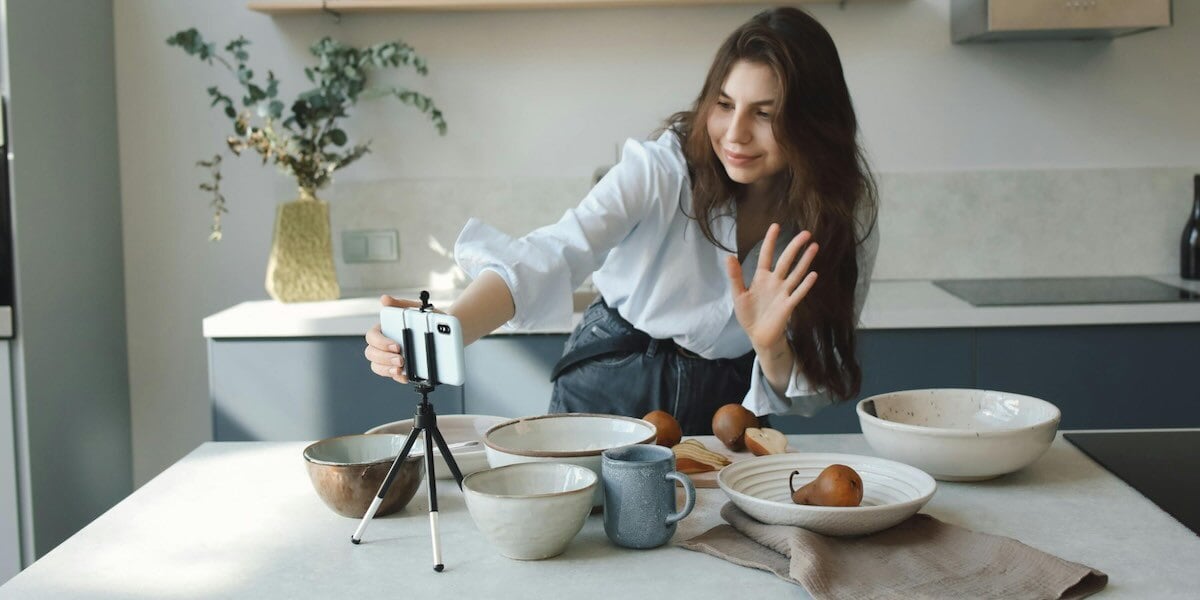
To shoppers today, a picture is worth way more than a thousand words.
Recent user-generated content statistics highlight how buyers overwhelmingly trust UGC over stock photos (or worse, no photos at all).
Consumers need to see products in the hands of real people before they're ready to purchase.
That’s why UGC photos are crucial. Below we break down how brands are using UGC images to promote products, boost conversions and build trust with their communities.
What is a UGC Photo?
A UGC photo is a picture shared by consumers on social media, showing off shoppers' firsthand experiences with a product or brand.
These snapshots offer a more authentic and engaging way for brands to promote products.
Below is an example of how brands can both promote and encourage user-generated content via on-site photos. Note how the Humane Company uses UGC photos on its website to highlight satisfied customers, providing a branded hashtag to get others to share their own photos.

Simple enough, right?
But UGC photos are more than just static images by themselves. They can also include:
- Customer galleries and slideshows
- Customer-submitted reviews
- Hashtag photos
- UGC ads
- Shoppable UGC
Check out how Bird Collective uses customer-submitted photos in their reviews.
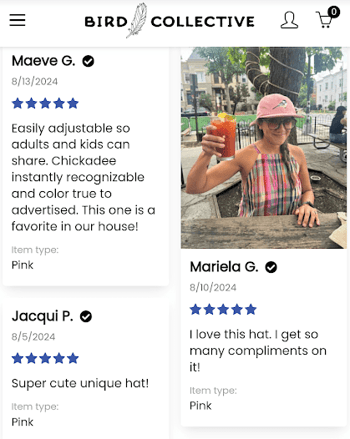
This highlights how brands see the benefits of UGC by boosting conversions on product pages.
5 UGC Photo Examples & Ideas for Brands
With the right UGC strategy, brands can get a ton of promotional mileage out of their customer and influencer photos. Below are five examples of brands using UGC pictures and inspiration to help your brand do the same.
1. Customer Review Photos
These are photos that customers submit when they write a product review on your website.
Coupling visual UGC with a written review is a one-two punch to build trust.
Below is an example from Good Dye Young. The brand allows customers to submit photos alongside their star ratings and written reviews.


This allows satisfied customers to show and tell the results of a product to build trust and serve as powerful social proof. Not to mention provide another channel for brands to get more UGC.
Just note that moderating the UGC that’s submitted to your website is key for the sake of quality control and ensuring that photos are authentic and appropriate.
2. UGC Photo Galleries
Single customer photos are nice but galleries are great!
With UGC galleries, brands can showcase satisfied customers and provide a wider variety of product inspiration.
Below is an example from Crate and Barrel. They have a UGC image gallery on their homepage and a shoppable photo feed. Shoppers can go directly from a piece of UGC to a product page.


Manic Panic has a “Shop The Look” section on its website that makes it easy to look at inspirational photos from customers. For a product such as a hair dye that requires a lot of research and customers might be anxious about making the right choice, UGC is a must-have.
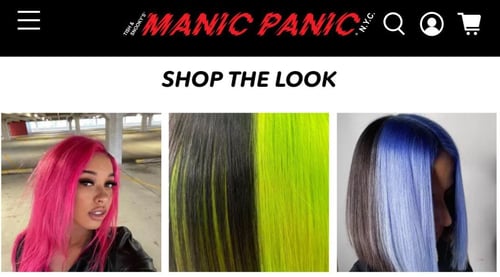
Again, shoppers want to see how products actually look. These galleries do the trick!
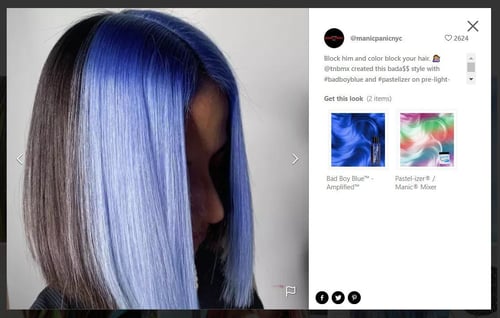
As a bonus, these UGC images also help keep visitors on-site and mean they don’t have to bounce around to more platforms to do research. You’ve already done the hard work to get them on those product pages, right? These photos help you convert them.
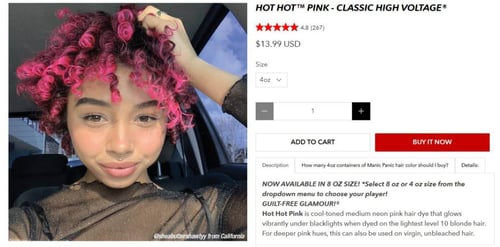
Given that 88% of consumers want to see authentic product photos before making a purchase, this is an actionable example of how UGC drives sales as shoppers can see that the results from your product are real.
3. Hashtag UGC
These are photos generated by your branded hashtag.
For example, Purple encourages customers and creators to post content on Instagram using their #sleeppurple hashtag. This tag is promoted on both the brand's website and IG bio.

Another direct way to get customer photos from a hashtag is through a UGC contest or giveaway. For example, Liftdown gives away its beanies to customers who tag the brand in their photos on Instagram.

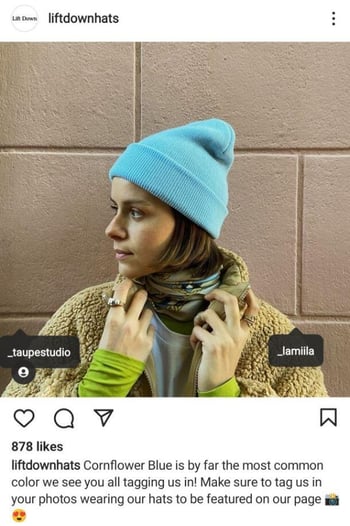
The takeaway? Brands shouldn’t be shy about asking satisfied customers to post product photos. Hashtags are a low-hanging way to encourage more user-generated content while contests and giveaways are more direct and require active moderation.
4. UGC Photo Ads
UGC photo ads are paid promotions that showcase real people using your products.
Brands have multiple options when it comes to getting content and running UGC photo ads:
- These ads can be shared as single images or Carousels on Instagram from a creator's account directly via Partnership ads.
- You can also promote ads featuring influencers or UGC creators from your own account (granted you have the rights to the photos) using Carousels or photos on TikTok.
Here is an example of a UGC photo ad from ILIA Beauty. Note the Instagram Carousel features a variety of different customer photos.

This highlights how you can show off multiple products in action with UGC photos.
While the most popular UGC ads are videos, photos are valuable as part of your marketing mix. Food for thought: Carousels are among the most popular types of UGC on Instagram. Since Carousel ads are interactive, they're a great way to drive engagement.
5. Shoppable UGC
Shoppable UGC is another way to drive conversions directly from creator content using a link in bio tool. With these tools, consumers can actually shop directly via photo feeds from Instagram.
For example, when you click on Krave Beauty’s bio link you're taken to a feed of photos.

And once you click through, you're sent to a relevant product page.

This is another great example of how UGC photos can drive conversions. Not to mention how brands can squeeze more out of their user-generated content through strategic repurposing.
Are UGC Photos or Videos Better for Brands?
Depends on who you ask.
We'll bite: UGC videos on TikTok and Instagram Reels are booming right now. Short-form influencer videos are among the most popular types of content brands are investing in.
The reality, though? Visual UGC in any form is super valuable to brands.
A few specific benefits of user-generated photos for marketers include:
- Easy for customers and UGC creators to make. While filming a UGC video is simple enough on smartphones, it only takes a couple of seconds to snap and even upload a photo.
- Smaller file sizes. This is an important detail if you plan on including customer photos and UGC galleries on your website.
- Diversify your content strategy. Our internal platform data notes that many brands in the CPG space still invest heavily in influencer photos for Instagram Stories and In-Feed Posts. The fact that Carousel and Story posts still perform super well on IG is a big reason why.
Consider user-generated photos and videos are proven to lift conversion rates, increase average order value and reduce e-commerce returns. Brands shouldn't necessarily pit UGC photos and videos against each other since there's a time and place for both.
Do Brands Need to Ask for Permission for UGC Photos?
Yes, 100%.
Brands should always ask permission before using UGC photos in any type of promotion. This includes organic social posts and reposts.
Obtaining explicit UGC usage rights will help you not only avoid legal issues but also show creators that you respect them.
Permissions for UGC photos can be obtained manually through emails, DMs, comments and even hashtags. Beyond that, you can use a dedicated UGC platform like Statusphere with built-in content rights to speed up the process of getting user-generated content at scale.
How Brands Can Get More UGC Photos
Getting user-generated content that shows your product in use is the most authentic way to engage customers.
Because when people see a product work for someone else, they trust it can work for them.
But simply gathering photos from customers isn’t enough. Brands need to get permission from each creator to use their UGC and that’s where the headache starts.
All of that back-and-forth is a huge time-sink. That’s where Statusphere comes in.
Our platform matches brands with vetted micro-influencers to get rights-ready UGC at scale. Permission and usage rights are built into our platform so you get UGC photos and videos faster. All ready to repurpose across your key channels including ads, product pages and beyond.
We’ve already generated 75,000+ pieces of rights-ready content for 400+ brands.
Want to see how our software works? Get in touch with one of our experts to learn how we can scale your UGC marketing efforts with guaranteed content from vetted creators.
